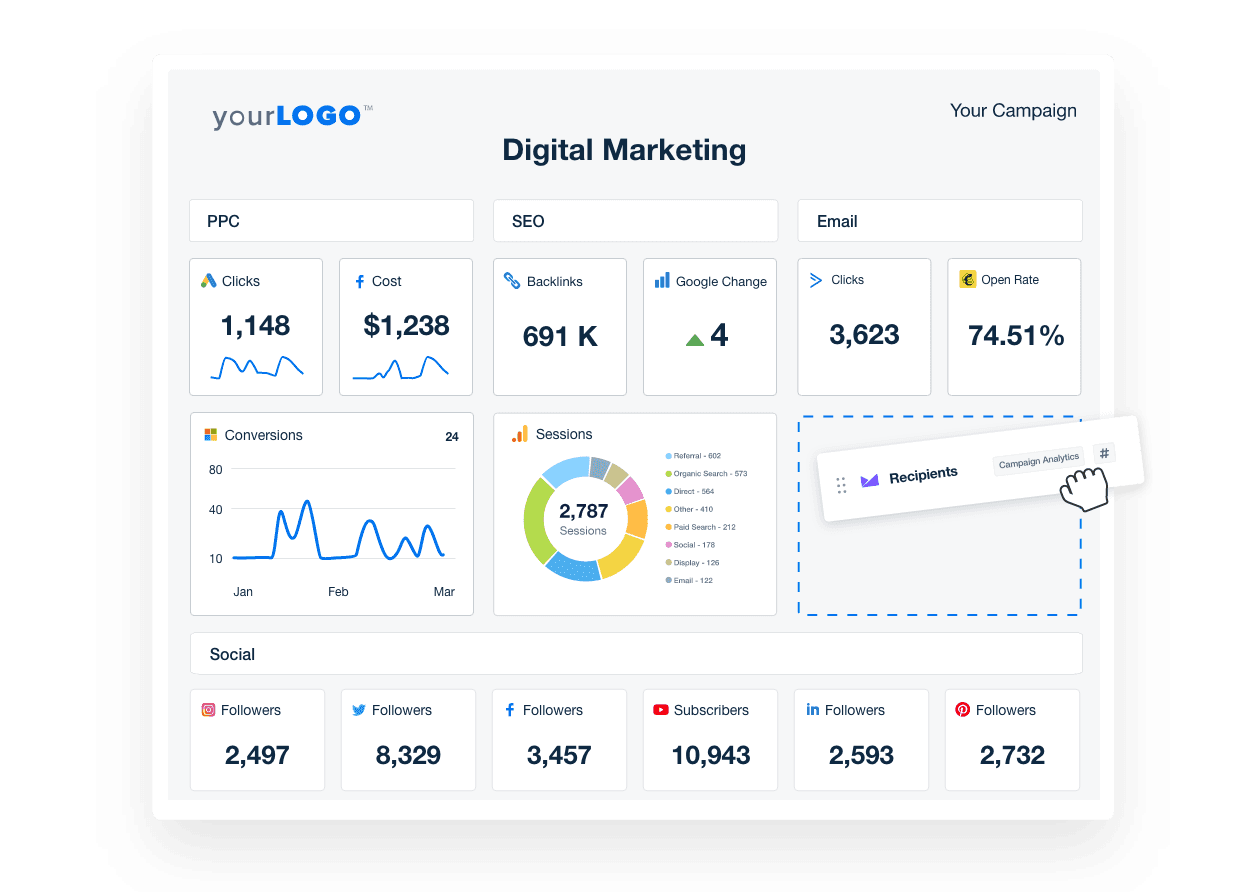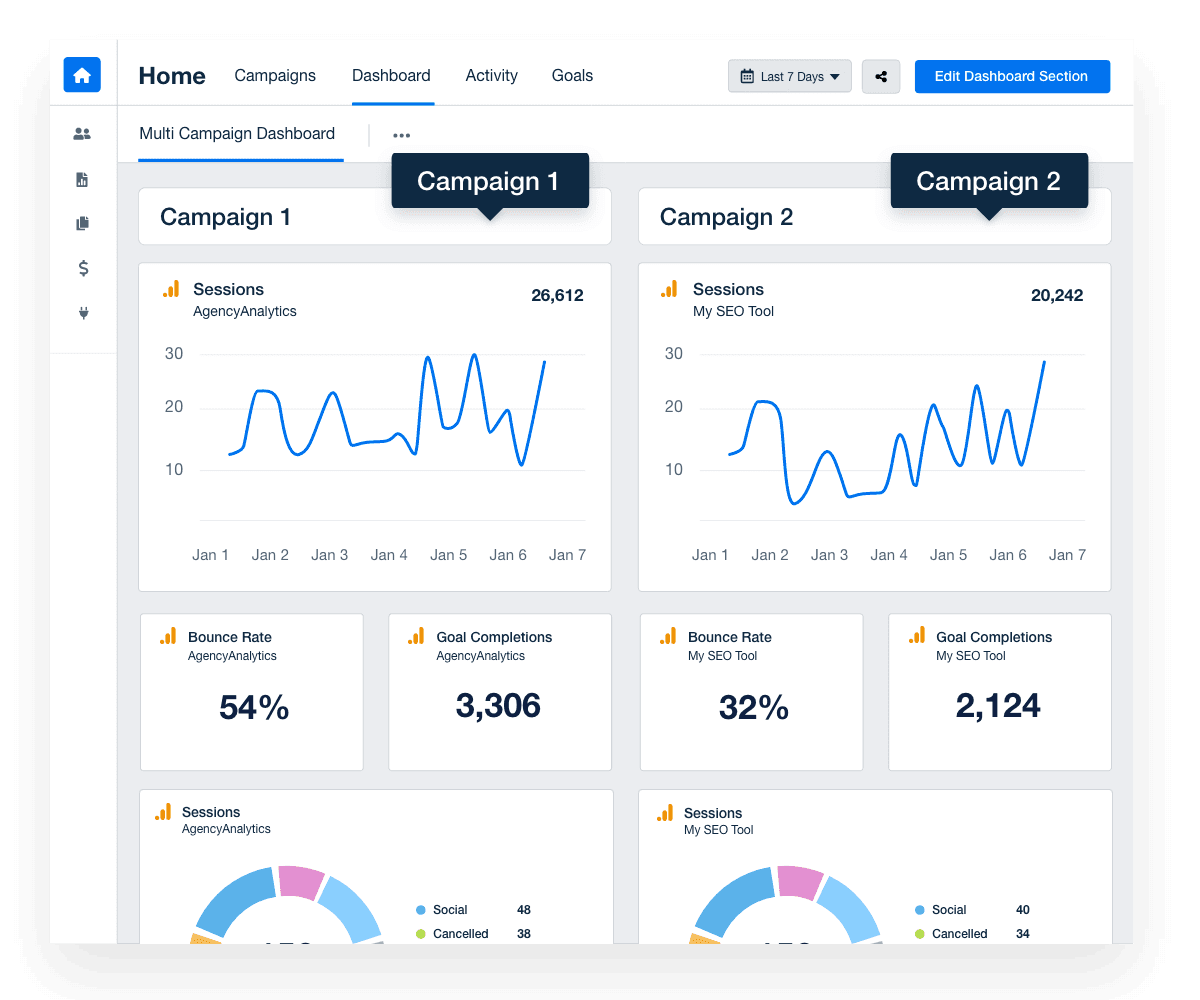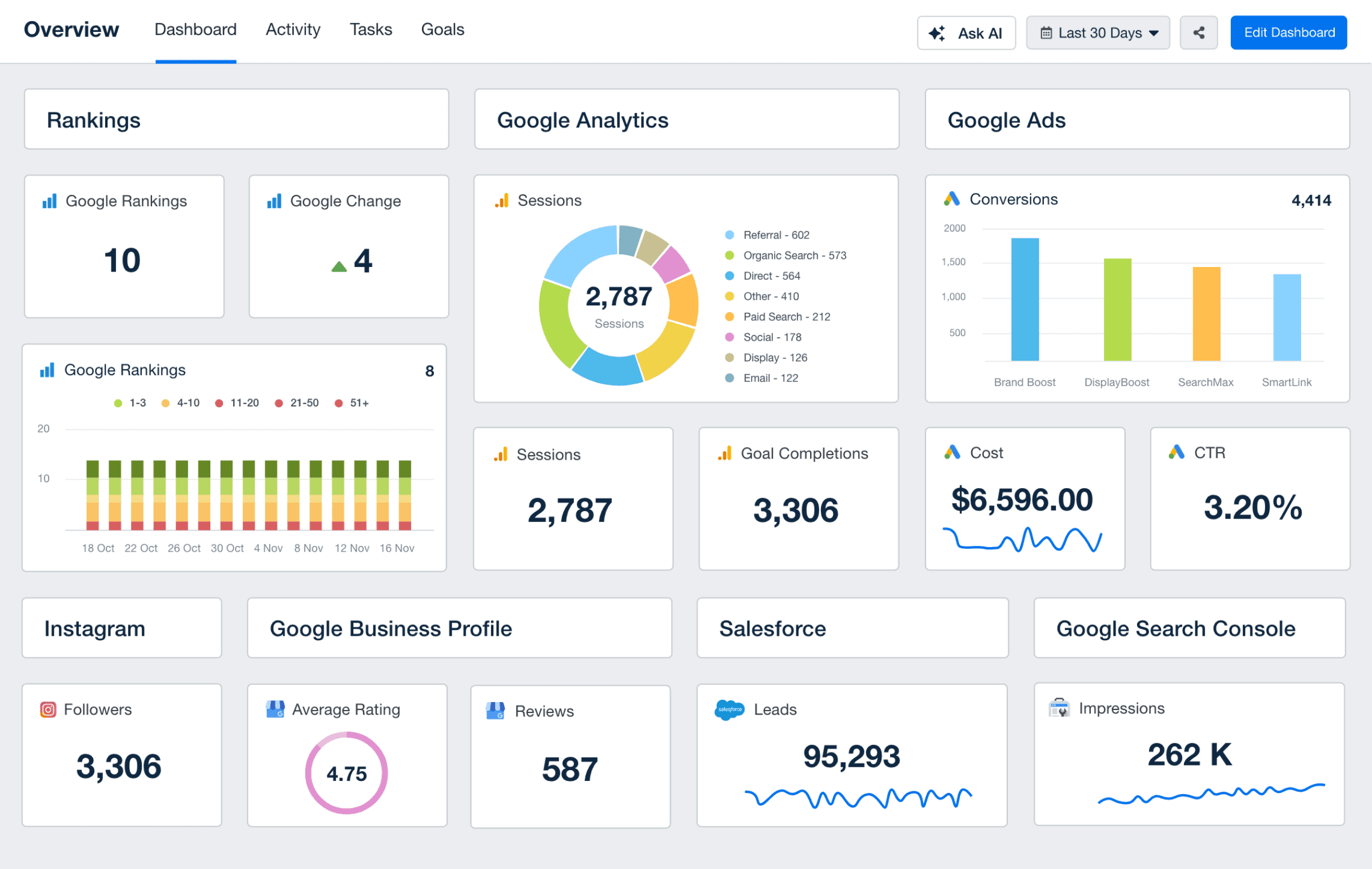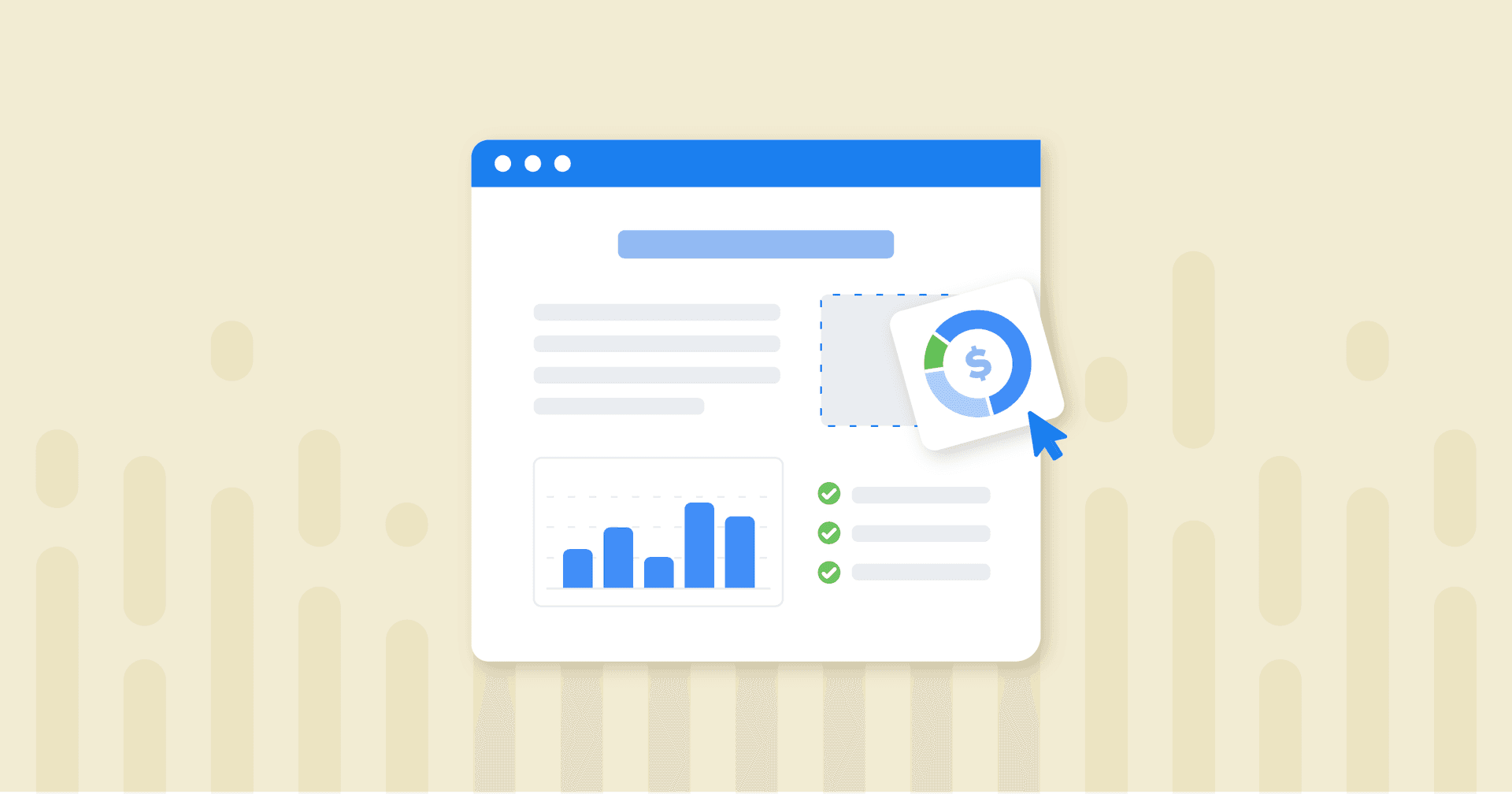Table of Contents
Quick Summary:
This article is a complete guide to the most important digital marketing KPIs to help agencies choose metrics that align with their client goals and drive results. It covers how to identify relevant KPIs, avoid distractions from non-actionable metrics, and streamline tracking with tools like AgencyAnalytics.
When you’re managing digital marketing campaigns, keeping track of the right metrics is essential. Whether you’re running a small agency or managing hundreds of clients, understanding and tracking the right KPIs (Key Performance Indicators) will make or break your success. With so many metrics to choose from, it’s easy to get caught up in data overload—or worse, focus on metrics that don’t actually drive results.
That’s why we’ve put together this comprehensive guide to digital marketing KPIs. We’ll walk you through the most critical metrics, explain why they matter, and show you how to measure them effectively. Plus, we’ll help you cut through the noise and identify which KPIs actually impact client outcomes.
And here’s the kicker: With the right tools, tracking these metrics doesn’t have to eat up your day. AgencyAnalytics makes it easy to track KPIs, automate reporting, and even get actionable insights when something changes.
Let’s dive in and make sense of the metrics that matter most.
What Are Digital Marketing KPIs?
Digital marketing KPIs are measurable values that demonstrate how effectively a marketing strategy is achieving specific objectives. In simple terms, they’re the metrics that tell you whether your campaigns are working—or if it’s time to rethink your approach.
Think of KPIs as your agency’s performance dashboard. They give you a snapshot of progress, highlighting areas that are thriving and those that need attention. Whether your goal is to increase brand awareness, drive website traffic, or boost conversions, KPIs give you the data to back up your strategy.
Why KPIs Matter for Marketing Agencies
For agencies managing multiple client accounts, KPIs provide a data-driven foundation to demonstrate the value of your work. They help:
Showcase Success: Prove your strategy is working with concrete numbers.
Identify Problems Early: Spot declining metrics before they become major issues.
Improve Decision-Making: Make data-driven adjustments instead of relying on gut feelings.
Build Client Trust: Use transparent reporting to keep clients confident in your approach.
Different Types of Digital Marketing KPIs
Digital marketing KPIs generally fall into a few categories:
1. Generic Digital Marketing KPIs: Metrics that track overall marketing performance.
2. Conversion & Sales Metrics: KPIs focused on turning visitors into leads or customers.
3. Financial Metrics: Indicators that track cost efficiency and profitability.
Knowing the difference between these categories will help you select the most relevant metrics based on your client’s goals.
Why Measuring Digital Marketing KPIs Matters
Measuring digital marketing KPIs is considered best practice because it’s essential for agency success. Without clear metrics, it’s hard to understand the results. You might think your strategy is working, but without concrete data to back it up, you’re just guessing.
Tracking KPIs helps agencies:
Demonstrate Value to Clients: Show how your efforts are directly contributing to their success.
Optimize Campaigns in Real-Time: Spot what’s working and what isn’t—fast.
Make Data-Driven Decisions: Replace gut instincts with evidence-based strategy adjustments.
Identify Growth Opportunities: Discover which channels or tactics are outperforming expectations.
The Risk of Ignoring KPIs
Failing to measure KPIs wastes time and resources—and worse, it risks damaging client relationships. If your clients feel like they’re in the dark about their campaign performance, it won’t take long before they start questioning your value. That’s why consistent, transparent reporting is key to maintaining client trust and retention.
Shine a light on your client's top KPIs with a customizable campaign performance dashboard, or any of the marketing report and dashboard templates.
How AgencyAnalytics Makes KPI Tracking Simple
With AgencyAnalytics’ digital marketing dashboards, tracking KPIs is as straightforward as it gets. From real-time performance tracking to automated client reports, you’ll never be caught off guard by unexpected changes. Plus, with insights features that spot trends and anomalies, you’ll know exactly when to pivot your strategy.

How To Pick the Most Important Digital Marketing KPIs
Choosing the right KPIs for your clients isn’t about tracking everything under the sun. It’s about focusing on metrics that directly align with their business goals. Whether it’s driving more leads, boosting brand awareness, or increasing customer retention, every KPI you choose should serve a specific purpose.
During the sales process, we ask the client what KPIs they want to track, often they're unsure and so we make recommendations based on their overall goals.
Paul Morris, Managing Director, Superb Digital
Step 1: Understand Client Objectives
Start by having a conversation with your client to clarify their goals. Are they aiming to increase traffic, generate more leads, or improve customer retention? Defining clear objectives will guide you in selecting relevant KPIs.
Step 2: Align KPIs With Campaign Goals
Once you know the client’s objectives, map those goals to specific KPIs. For example:
Lead Generation Campaign: Track Cost Per Lead (CPL) and Conversion Rate.
Brand Awareness Campaign: Monitor Impressions and Reach.
Sales-Focused Campaign: Keep an eye on Revenue, Customer Acquisition Cost (CAC), and Return on Ad Spend (ROAS).
Step 3: Choose Actionable Metrics
Focus on KPIs that not only reflect progress but also provide actionable insights. If a metric doesn’t help guide decisions or improvements, it’s probably not worth tracking.
Step 4: Prioritize Simplicity and Clarity
A KPI dashboard crammed with dozens of metrics won’t impress your clients—it’ll overwhelm them. Stick to a core set of KPIs that clearly communicate results without unnecessary complexity.
Step 5: Use Tools That Simplify Tracking
The key to efficient KPI management is automation. With AgencyAnalytics’ marketing dashboard templates, pull data from 80+ sources into one place, making it easier to present clear, actionable reports to your clients. Plus, set up alerts to notify you when a KPI falls outside the expected range—no manual monitoring is required.
At our agency, we believe that metrics are only useful if they help to drive decision-making. As a result, we focus on identifying actionable metrics that can be used to inform and improve our marketing efforts. To do this, we start by taking a close look at our goals and objectives. We then identify the key performance indicators (KPIs) that will help us measure progress towards those goals. Once we have a clear understanding of our KPIs, we can choose the metrics that will provide the most insights into our performance. By taking this approach, we ensure that our metrics are always actionable and informative.
Guy Hudson, Founder, Bespoke Marketing Plans

Use multi-client dashboards to track key KPIs for all your clients in one place. Gain a bird’s eye view and a front row seat to trends as they form. Try AgencyAnalytics free for 14 days!
The Top 10 Critical Digital Marketing KPIs
Not all KPIs are created equal. While there are countless metrics to track, some stand out as essential for evaluating digital marketing performance. Here are the top 10 critical KPIs every agency should monitor to demonstrate value and drive client success.
Generic Digital Marketing KPIs
1. Impressions
Impressions represent how often your client’s content or ads are shown to users. While it doesn’t measure engagement or actions taken, impressions help gauge the reach of your digital marketing efforts.
Why It Matters: High impressions mean your marketing campaigns are getting in front of potential customers. However, impressions alone don’t guarantee engagement or conversions—so pair this metric with others, like click-through rate (CTR), to get a fuller picture.
2. Clicks
Clicks measure how many users interact with your client’s content by clicking on links, ads, or social media posts. This KPI helps evaluate how well your digital marketing strategy is capturing attention.
Why It Matters: Clicks indicate initial interest and are a key step in moving users through the marketing funnel. A high click volume suggests your messaging resonates with the audience, while a low click count might mean your call to action needs work.
3. Click-Through Rate (CTR)
CTR shows the percentage of people who clicked on your client’s ad or link compared to the number of impressions. It’s a critical KPI for understanding user interaction and the effectiveness of ad spend.
Why It Matters: A high CTR means the content is engaging and relevant, while a low CTR might indicate a mismatch between the audience and the messaging. Improving CTR will boost website traffic and help optimize the marketing spend.
Conversion & Sales Metrics
4. Conversions
A conversion occurs when a user takes a desired action, like signing up for a newsletter or making a purchase. Conversions are the ultimate goal of most digital marketing initiatives and a strong indicator of campaign success.
Why It Matters: Tracking conversions helps you understand how well your digital marketing efforts are driving valuable actions. Low conversions may signal issues with landing pages, ad relevance, or user experience.
5. Conversion Rate
The conversion rate shows the percentage of visitors who complete a conversion action out of the total number of visitors. It’s a direct indicator of how persuasive the content or offer is.
Why It Matters: A high conversion rate means the strategy is effectively turning visitors into leads or customers. A low conversion rate, on the other hand, could indicate issues with the landing pages, ad copy, or targeting.
6. Marketing Qualified Leads (MQLs)
MQLs are leads that have shown enough interest to be considered potential customers but aren’t quite ready to buy yet. They’ve engaged with the content, downloaded a resource, or signed up for a newsletter.
Why It Matters: MQLs are critical for marketing and sales teams because they represent opportunities that can be nurtured into paying customers. Efficiently managing MQLs helps improve customer retention rate and overall marketing investment.
7. Sales Qualified Leads (SQLs)
SQLs are leads that have been vetted and are ready to move to the sales team for follow-up. They’re further down the funnel than MQLs and are more likely to convert into paying customers.
Why It Matters: SQLs bridge the gap between marketing and sales teams by identifying leads that are ready for direct follow-up. Prioritizing SQLs means focusing on high-quality prospects, improving sales efficiency, and maximizing ROI.
Financial Metrics
8. Conversion Cost
Conversion cost measures how much you spend to generate a single conversion (e.g. a purchase, form submission or sign-up), including expenses like ad spend and other marketing costs. It’s a critical KPI for assessing the cost-effectiveness of marketing campaigns.
Why It Matters: Keeping conversion costs low ensures a positive return on investment (ROI) by acquiring new customers efficiently. High conversion costs may indicate poorly targeted advertising channels or mismatched user behavior. Monitoring this metric helps you spot trends and make adjustments to boost performance.
9. Cost Per Lead (CPL)
CPL calculates how much it costs to acquire a new lead, factoring in advertising campaigns, social media engagement, and email marketing KPIs. It’s essential to track this metric across different advertising channels to understand which platforms generate the most cost-effective leads.
Why It Matters: A low CPL indicates that your digital marketing strategy is efficient and attracting potential customers without overspending. On the other hand, a high CPL might suggest that your marketing teams need to reassess targeting strategies or optimize SEO efforts to generate more website traffic and leads at a lower cost.
10. Customer Acquisition Cost (CAC)
CAC measures the total cost of acquiring a paying customer, including marketing expenses, sales expenses, and overhead. It’s one of the most important digital marketing metrics because it directly impacts net profit and therefore long-term business sustainability.
Why It Matters: Lowering CAC improves return on ad spend (ROAS) and boosts customer satisfaction. High CAC might indicate inefficient advertising channels or targeting issues. Analyzing CAC alongside customer lifetime value (CLV) helps ensure acquisition costs don’t exceed the total revenue generated.

Managing multiple KPIs from various platforms can be overwhelming. With AgencyAnalytics’ automated reporting, effortlessly track and visualize these critical metrics in one place. Save time, reduce manual effort, and keep your clients in the loop with real-time data. Try it free for 14 days!
What KPIs Don’t Need Your Attention?
Not every metric deserves your attention. While tracking performance is crucial, obsessing over metrics that don’t align with your client’s goals will only waste time and resources. Here’s a reality check: Just because a metric looks impressive on paper doesn’t mean it’s useful. The key is choosing KPIs that are relevant to the client’s business, and that help measure real progress.
Why Relevance Matters
One common mistake agencies make is tracking every possible metric, even when they don’t matter to the client. An established brand with high visibility probably doesn’t need to focus on increasing brand awareness—they might be more concerned with customer lifetime value (CLV) or return on investment (ROI). On the other hand, a new business trying to build an audience might care more about social media engagement and website traffic.
It’s all about context. The right marketing KPIs vary based on the client’s industry, business stage, and specific objectives. What’s relevant to one client might be completely irrelevant to another.
A lot of agencies doing subpar work include vanity metrics as a way to prove value and get clients excited. Unfortunately, after time and a lot of money, the clients realize that these KPIs are insignificant.
Michael Stearns, Founder, Ascend Digital Agency
Choosing KPIs That Drive Results
Before including a metric in your reporting, ask yourself:
Does it align with the client’s business goals?
Can it guide meaningful strategy adjustments?
Is it tied to revenue, ROI, or customer growth?
Is it actionable, or just nice to have?
If the answer to most of these questions is “no,” it’s likely not worth tracking. The smartest approach is to tailor your KPI strategy to each client, focusing on metrics that showcase tangible results.

With AgencyAnalytics dashboards, customize reports to highlight the KPIs that truly matter to each client. Deliver data that drives decisions, and stay ahead with automated alerts that help you spot shifts and identify trends in real time. Sign up for your free 14-day trial!
How To Track Digital Marketing KPIs To Improve Client Outcomes
Tracking KPIs efficiently differs from delivering consistent results and scrambling to explain underperformance. The goal isn’t just to collect data, but instead to gain insights that drive smarter decisions. Here’s how to set up a reliable KPI tracking system that keeps clients happy and your team on track.
1. Automate Your Reporting Process
Manual tracking is time-consuming and prone to human error. Automating your reporting saves hours and ensures accuracy. AgencyAnalytics digital marketing dashboard templates make it easy to integrate data from dozens of sources and create real-time reports to share with clients.
Agency Tip: Set up automated alerts to get notified of any unusual KPI changes—like a sudden drop in traffic or a spike in cost per lead.
2. Choose the Right Tools
Having the right tools in place makes tracking KPIs seamless. Look for features like:
Customizable Dashboards: Tailor metrics to each client’s goals.
Multi-Channel Integration: Pull data from social media, Google Ads, SEO tools, and more.
Automated Reports: Schedule regular updates to keep clients informed.
AgencyAnalytics checks all these boxes, helping you track the most important digital marketing metrics without manual effort.
3. Keep Clients in the Loop
It’s important to track KPIs, but perhaps even more important to communicate their progress to clients. Use client-friendly reports that make data easy to digest, and schedule them to be sent at the cadence that suits your relationship.
According to the AgencyAnalytics Marketing Agency Benchmarks Survey, the majority of agencies send reports monthly.

With Smart Reports from AgencyAnalytics, create your report in as little as 11 seconds, schedule, and send. It’s that easy.
4. Monitor Trends, Not Just Numbers
It’s easy to focus on raw numbers, but trends tell the real story. Monitoring changes over time helps you spot patterns and predict future performance. For example:
A consistent increase in CTR indicates that your messaging is resonating.
A sudden drop in MQLs might signal that your targeting needs refinement.
By keeping an eye on trends, you’ll be able to make proactive adjustments before minor issues become major problems. With features like anomaly detection, AgencyAnalytics users can rest assured that any issues will be flagged to be addressed immediately, avoiding long-term negative outcomes.
Further, AgencyAnalytics empowers agencies to predict how trends will play out with the forecasting feature. Show clients both optimistic and pessimistic future models to provide context for your strategic suggestions.
5. Take Action on Insights
Data without action is just noise. When you spot a problem, don’t just note it—address it. If your conversion rate is declining, dig into potential causes:
Are landing pages slow or broken?
Is your messaging consistent with ad copy?
Have you changed targeting settings recently?
Use AgencyAnalytics’ Ask AI feature to surface actionable insights on next steps. Instead of manually analyzing each data point, let AI highlight areas that need attention and suggest fixes.
6. Regularly Review and Refine KPIs
Digital marketing is dynamic, and what worked last month might not work now. Regularly review your KPI strategy and adapt to changing client needs or market conditions. Make KPI reviews part of your routine to ensure your metrics remain relevant and actionable.
Conclusion & Key Takeaways
Tracking the right digital marketing metrics is the key to proving your agency’s value and delivering real results for your clients. Instead of drowning in data, focus on key performance indicators that align with each client’s goals and provide actionable insights.
Whether you’re tracking conversion rates, customer acquisition costs, or return on investment (ROI), the most impactful KPIs are the ones that guide strategy and demonstrate progress.
To make KPI tracking seamless, use tools that automate data collection and reporting. AgencyAnalytics not only saves time but also helps digital marketers identify trends and detect performance shifts before they become problems. By simplifying your reporting process and keeping clients in the loop with real-time data, you build trust and showcase the value your agency delivers.
At the end of the day, your clients don’t just want data—what they really want is results. With the right KPI tracking and reporting strategy, you’ll build stronger client relationships and keep marketing efforts moving in the right direction.
Leverage AgencyAnalytics to simplify your KPI tracking and transform how you report performance. It’s time to make data your agency’s greatest asset–try it free for 14 days!
Impress clients and save hours with custom, automated reporting.
Join 7,000+ agencies that create reports in under 30 minutes per client using AgencyAnalytics. Get started for free. No credit card required.
FAQs About Digital Marketing KPIs
Still have questions about digital marketing KPIs? Don’t worry! We’ve got you covered. Here are the most common questions answered to help you track and report key performance indicators with ease.
Measure KPIs by collecting data from relevant channels (like Google Analytics, Facebook Ads, and CRM systems) and consolidating it in a single reporting dashboard. Automating this process with tools like AgencyAnalytics saves time and reduces errors.
The most important KPIs depend on client goals but commonly include Conversion Rate, Cost Per Lead (CPL), Customer Acquisition Cost (CAC), and Click-Through Rate (CTR).
Start by understanding your client’s objectives, then select KPIs that directly align with those goals. Focus on relevant KPIs that align with client goals and demonstrate measurable success.
To report digital marketing KPIs, gather data from all relevant sources like Google Analytics, social media, and ad platforms. Organize the metrics into a clear, easy-to-understand format that highlights progress toward client goals. With AgencyAnalytics, automate reporting and present real-time insights in customizable dashboards—saving time and keeping clients informed.

Written by
Alisha Chowdhury holds a degree in Business Management with a focus on Marketing. She brings hands-on experience in SEO, copywriting, social media, and content creation. Alisha is passionate about digital strategy and enjoys crafting content that informs, inspires, and provides value to others.
Read more posts by Alisha ChowdhurySee how 7,000+ marketing agencies help clients win
Free 14-day trial. No credit card required.






